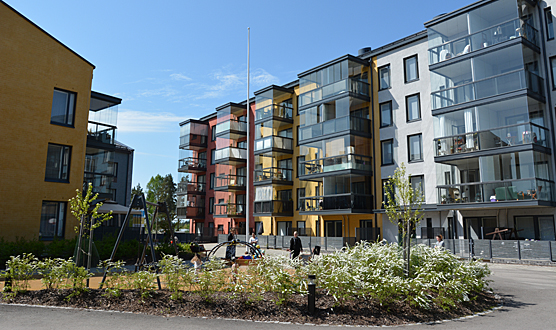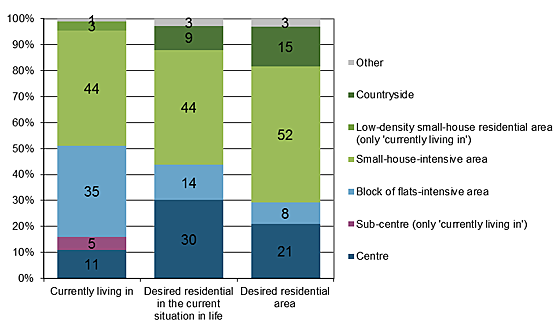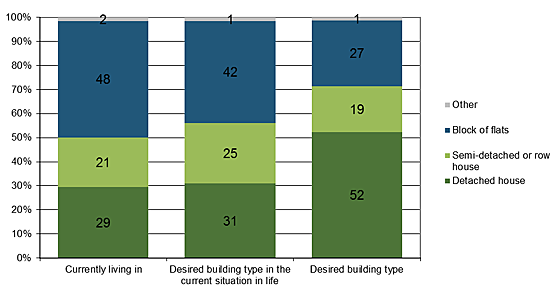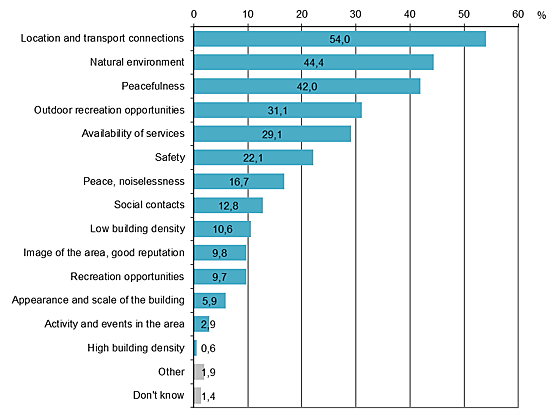Press release 2017-06-20 at 9:38

Picture: Anna Strandell / SYKE
According to the latest “Asukasbarometri” (Residents’ barometer) survey, more and more Finns want to live in an urban environment. Urbanisation is also seen in changes in life style such as the increased popularity of cafés and an increase in cycling. Location, good transport connections as well as a natural environment and peace and quiet are the most important factors affecting contentment in urban residential areas. The survey investigated the aspirations of over 10,000 people in urban areas regarding housing and the quality of residential areas.
Demand for living in the centre and in small house in the city
“Finns’ residential aspirations have urbanised since the beginning of the 2000s, i.e. the popularity of living in a flat in the city centre has increased and aspirations to live in a detached house have reduced. 30 per cent of respondents said that in their current stage in life they wanted to live in the centre, which is about double the number of people who do live like that at present. On the other hand, it was rarer for people to want to live in suburb areas dominated by blocks of flats”, said Anna Strandell, Senior Researcher at the Finnish Environment Institute, SYKE.
The people, who in their current stage of life most want to live in city centres and blocks of flats, are mainly young people, young adults, the elderly and those living alone. Ageing further increases the demand for living in city centres and blocks of flats. However, the greatest change in aspirations on where to live and in life styles has occurred in the 30-40 year-olds and in families with children whose aspirations for city centre living and living in blocks of flats have increased the most.
The advantage of city centres is the functional variety; they combine living, work, services, leisure opportunities and the availability of culture as well as good transport connections. Those living in city centres are also satisfied with the activity in the area, its image as well as the appearance and scale of buildings. People are less satisfied with the quality of the built environment and the level of services in areas dominated by blocks of flats. On the other hand, the strengths of these neighbourhoods are the natural environment, good sports and outdoor activities services as well as traffic safety.

Figure 1. The respondents’ (15–84-year-olds) residential area desires in comparison to the current residential area. The ‘current residential area’ has been generated on the basis of geographic data sets and its classification differs from the classification of desires. The sub-centres are similar to centre-like residential areas. Low-density small-house areas are considered to be either small-house-intensive or countryside. The ‘don’t know’ replies have been omitted from the desires to ensure comparability.
However, neighbourhoods dominated by individual family houses are still the most desired type of residential area. Most of all, Finns aspire to have more townhouses, where they can combine aspirations for their own garden, accessibility to local services on foot and good public transport connections. A family house that is part of a housing company such as terraced houses, semi-detached or townhouses in a good location is better suited to many people’s stage in life than a detached house further from the centre which requires maintenance and car ownership.
The increase in urban city centre residential environments and availability of townhouses is being aided by in-fill construction in existing residential areas. Of the respondents, 22 percent were opposed to in-fill construction in residential areas, 35 per cent reacted positively and the rest with caution. Attitudes to in-fill construction are almost as positive in areas dominated by blocks of flats as in low-density areas of individual houses.

Figure 2. The respondents’ (15–84-year-olds) building type desires in comparison to the current building type distribution. The ‘don’t know’ replies have been omitted of the desires to ensure comparability.
Cafés and restaurants as well as recycling points are the services most hoped for
Urbanisation and changes in lifestyle set new kinds of demand on the quality of residential areas and on services. In the survey, cafés and restaurants were overwhelmingly the first choice of services hoped for in residential areas. Cafés are important meeting places and working places. The second most wanted service among the respondents was a waste sorting or recycling point. The traditional basic services, a grocery shop, public transport, bank and post-office services, lagged behind these. Many basic services are accessed outside residential areas or are accessed as digital and automated services. However, elderly people have suffered from the digitalisation of services and the reduction in service networks such as banks and post offices.
The increase in the popularity of cafés is related to the change in social relations in urban residential areas. Neighbourly social relations have partly switched to social media and part have been replaced by communities that are not tied to the neighbourhood. However, social contacts in residential areas are still held in relatively high regard as a selection criteria on where to live, and ageing increases the importance of community in the immediate environment.
Residents are mainly satisfied with their residential area’s parks and outdoor activity facilities, but in addition to green areas, the urban dwellers also miss many kinds of built outdoor activity and sports services. These are most wanted on the edges of urban areas where the construction is low density detached houses.
The proportion of cycling as a means of transport for shopping and travel to work has increased considerably; as many as one fifth of commuting journeys are made by bicycle at least for part of the year. 30 - 40 year-olds especially cycle more than before and use cars less. Almost two fifths of 15 - 40 year-olds could live in residential areas without cars. On the other hand, dissatisfaction with public transport services has increased particularly in the smallest urban areas and areas of low density detached houses.
Living in multiple places is also on the increase. For example, among families with school-age children the size of every fifth family changes during the month which is mainly because children from divorced families alternate where they live. Living in blocks of flats or densely-built areas increases holiday travel and time spent at holiday homes.
Location and transport connections the most important contentment factor - problems with disturbances cause by traffic
Most residents are content in their city centres, suburban neighbourhoods and low-density family home areas. The most important contentment factors for residential areas are the location and good transport connections, a natural environment and peace and quiet. Location and transport connections have overtaken peace and quiet as the contentment factors that received the most mentions. Disturbances caused by traffic, such as noise and accidents, are the major factors causing lack of contentment in residential areas. Other factors giving rise to discontent are the lack of services, lack of parking places as well as poor public transport connections or bicycle and pedestrian routes.

Figure 3. The most important attractiveness factors of the residential area (15–84-year-olds). The share of those who mentioned a factor.
The 2016 “Asukasbarometri” is a survey of the quality of urban residential environments and aspirations for housing carried out in urban areas with over 10,000 residents. This is now the fourth time this national monitoring survey has been carried out and for the first time it gives realistic information about how aspirations differ from how people currently live. The survey was carried out as a postal and internet questionnaire and 3,005 people between the ages of 15 to 84 responded. The research is funded by the Ministry of the Environment and the Finnish Environment Institute and it is carried out by the Finnish Environment Institute.
Pictures for media
Further information:
Anna Strandell, Senior Researcher, Finnish Environment Institute SYKE
tel. +358 (0) 295 251 657, firstname.lastname@ymparisto.fi